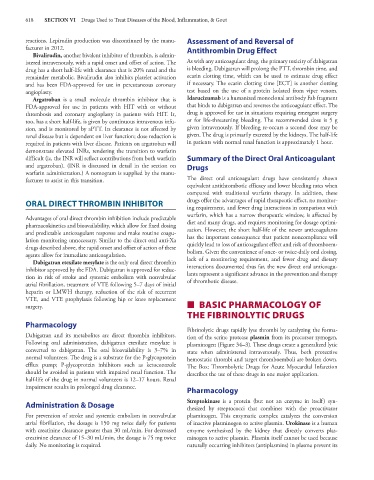Page 632 - Basic _ Clinical Pharmacology ( PDFDrive )
P. 632
618 SECTION VI Drugs Used to Treat Diseases of the Blood, Inflammation, & Gout
reactions. Lepirudin production was discontinued by the manu- Assessment of and Reversal of
facturer in 2012. Antithrombin Drug Effect
Bivalirudin, another bivalent inhibitor of thrombin, is admin-
istered intravenously, with a rapid onset and offset of action. The As with any anticoagulant drug, the primary toxicity of dabigatran
drug has a short half-life with clearance that is 20% renal and the is bleeding. Dabigatran will prolong the PTT, thrombin time, and
remainder metabolic. Bivalirudin also inhibits platelet activation ecarin clotting time, which can be used to estimate drug effect
and has been FDA-approved for use in percutaneous coronary if necessary. The ecarin clotting time [ECT] is another clotting
angioplasty. test based on the use of a protein isolated from viper venom.
Argatroban is a small molecule thrombin inhibitor that is Idarucizumab is a humanized monoclonal antibody Fab fragment
FDA-approved for use in patients with HIT with or without that binds to dabigatran and reverses the anticoagulant effect. The
thrombosis and coronary angioplasty in patients with HIT. It, drug is approved for use in situations requiring emergent surgery
too, has a short half-life, is given by continuous intravenous infu- or for life-threatening bleeding. The recommended dose is 5 g
sion, and is monitored by aPTT. Its clearance is not affected by given intravenously. If bleeding re-occurs a second dose may be
renal disease but is dependent on liver function; dose reduction is given. The drug is primarily excreted by the kidneys. The half-life
required in patients with liver disease. Patients on argatroban will in patients with normal renal function is approximately 1 hour.
demonstrate elevated INRs, rendering the transition to warfarin
difficult (ie, the INR will reflect contributions from both warfarin Summary of the Direct Oral Anticoagulant
and argatroban). (INR is discussed in detail in the section on Drugs
warfarin administration.) A nomogram is supplied by the manu-
facturer to assist in this transition. The direct oral anticoagulant drugs have consistently shown
equivalent antithrombotic efficacy and lower bleeding rates when
compared with traditional warfarin therapy. In addition, these
ORAL DIRECT THROMBIN INHIBITOR drugs offer the advantages of rapid therapeutic effect, no monitor-
ing requirement, and fewer drug interactions in comparison with
warfarin, which has a narrow therapeutic window, is affected by
Advantages of oral direct thrombin inhibition include predictable
pharmacokinetics and bioavailability, which allow for fixed dosing diet and many drugs, and requires monitoring for dosage optimi-
and predictable anticoagulant response and make routine coagu- zation. However, the short half-life of the newer anticoagulants
lation monitoring unnecessary. Similar to the direct oral anti-Xa has the important consequence that patient noncompliance will
drugs described above, the rapid onset and offset of action of these quickly lead to loss of anticoagulant effect and risk of thromboem-
agents allow for immediate anticoagulation. bolism. Given the convenience of once- or twice-daily oral dosing,
Dabigatran etexilate mesylate is the only oral direct thrombin lack of a monitoring requirement, and fewer drug and dietary
inhibitor approved by the FDA. Dabigatran is approved for reduc- interactions documented thus far, the new direct oral anticoagu-
tion in risk of stroke and systemic embolism with nonvalvular lants represent a significant advance in the prevention and therapy
atrial fibrillation, treatment of VTE following 5–7 days of initial of thrombotic disease.
heparin or LMWH therapy, reduction of the risk of recurrent
VTE, and VTE prophylaxis following hip or knee replacement
surgery. ■ BASIC PHARMACOLOGY OF
THE FIBRINOLYTIC DRUGS
Pharmacology
Fibrinolytic drugs rapidly lyse thrombi by catalyzing the forma-
Dabigatran and its metabolites are direct thrombin inhibitors. tion of the serine protease plasmin from its precursor zymogen,
Following oral administration, dabigatran etexilate mesylate is plasminogen (Figure 34–3). These drugs create a generalized lytic
converted to dabigatran. The oral bioavailability is 3–7% in state when administered intravenously. Thus, both protective
normal volunteers. The drug is a substrate for the P-glycoprotein hemostatic thrombi and target thromboemboli are broken down.
efflux pump; P-glycoprotein inhibitors such as ketoconazole The Box: Thrombolytic Drugs for Acute Myocardial Infarction
should be avoided in patients with impaired renal function. The describes the use of these drugs in one major application.
half-life of the drug in normal volunteers is 12–17 hours. Renal
impairment results in prolonged drug clearance.
Pharmacology
Administration & Dosage Streptokinase is a protein (but not an enzyme in itself) syn-
thesized by streptococci that combines with the proactivator
For prevention of stroke and systemic embolism in nonvalvular plasminogen. This enzymatic complex catalyzes the conversion
atrial fibrillation, the dosage is 150 mg twice daily for patients of inactive plasminogen to active plasmin. Urokinase is a human
with creatinine clearance greater than 30 mL/min. For decreased enzyme synthesized by the kidney that directly converts plas-
creatinine clearance of 15–30 mL/min, the dosage is 75 mg twice minogen to active plasmin. Plasmin itself cannot be used because
daily. No monitoring is required. naturally occurring inhibitors (antiplasmins) in plasma prevent its

